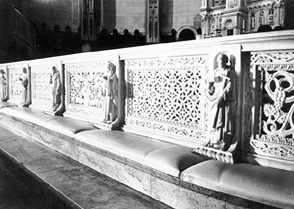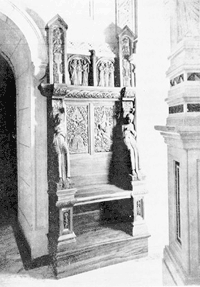|
Decoration includes such art forms as ceramics, furniture, glass,
ivory, metalwork and textiles, especially when used specifically for interiors,
religious and secular. In addition, decoration involves painting, sculpture,
relief, wood carving, mosaic and other aesthetic design elements which,
when combined, create the atmosphere or environment of a space. Many churches
were decorated with the designs and work of Nincheri. In addition to stained
glass and fresco, he was artistically involved in the design and execution
of decorations that ranged from metalwork, wood carving, sculpture, oil
painting and marouflage to the design of church furniture and furnishings.
As well as being an
accomplished painter and stained-glass master, he designed stage sets
and museums, engraved book plates, made architectural plans and was among
those who brought the technique of buon fresco to North America from Europe.
Nincheri directed and executed work to refurbish the interior of St.-Léon-de-Westmount
Church. He saw to every detail. This included the marble paneling with
Florentine mosaics at the bottom of the pillars and walls seen here, as
well as the floor which has 30 types of marble geometric tiles.
Within the churches
that Nincheri worked on, one can find murals and paintings in fresco,
marouflage, tempera and oil by Nincheri. Murals painted in fresco on fresh
plaster become integrated with the surface. (See the section on Fresco
on this website.)
Although marouflage
may be similar to fresco in appearance when viewed as a large-scale mural
piece, unlike fresco, marouflage is separate from the surface on which
it sits. It is the process of affixing painted canvas to a wall by means
of a specific type of cement. Murals are attached by the use of various
adhesives to plaster walls or other surfaces, which have been made level
and smooth. The traditional method is to coat the wall and canvas with
a thin even layer of the cement mixture of linseed oil and ground white
lead mixed to a consistency of stiff paste. Pressure is exerted with rubber
hand rollers to smooth the canvas over the wall and eliminate bubbles.
This process goes back to an early date and methods of production and
execution of marouflage work remain virtually unchanged today. Nincheri
produced many marouflage paintings that still exist in churches across
Canada. He also used marouflage for paintings he created to decorate a
secular building in the 1920's, the home of Oscar and Marius Dufresne
linked to this page.
Nincheri used traditional
oil technique to depict secular paintings and Biblical scenes similar
to the themes of his work in stained glass. The history of oil paints
made from vegetal drying oils goes back to the Middle Ages. Oil paints
are very flexible, can be easily manipulated and produce a wide range
of varied effects. The artist has the freedom to combine transparent and
opaque effects as well as glaze and body colour in a full range within
the same painting. The colours do not change to any great extent once
they are dry. Oil was widely adopted for use in easel painting in Europe
in the fifteenth century. By the middle of the sixteenth century the method
was in full swing and well developed. Since then until the invention of
acrylics, oil painting on canvas remained a standard technique for artists'
easel painting.
In addition to his
work in stained glass and painting, Nincheri designed church decoration
including woodwork and religious furnishings within the church. He worked
on the architectural ornamentation in hundreds of churches and at various
times he designed Stations of the Cross, wood carvings for pews, picked
tiles, designed mosaics and sculptures and hired artisans and artists.
There is still a need
to collect information concerning exactly what Nincheri made and designed
during his long and prosperous career as an artist and master artisan
whose works appear across Canada and in New England in the United States.
However, we are fully aware that he was certainly accomplished in many
facets of the fine and decorative arts and contributed greatly to the
history and culture of Canada, as evidenced by the fact that St.-Léon-de-Westmount
is a Canadian Cultural Heritage Site.
|
|

Marbre Saint-Léon-de-Westmount.
Marble designed by Nincheri. Executed by Guido Casini

Saint-Léon-de-Westmount. Detail of Marble Communion Rail.Designed by Nincheri.
Executed by Guido Casini

Saint-Léon-de-Westmount. Choir stall - Honduras walnut. Designed by Nincheri.
Carved by Alviero Marchi.
|